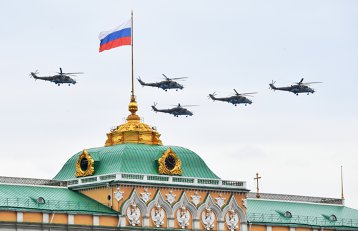
U.S’s defence investments or what is beyond the final border of national security costs

The American President, Donald Trump, signed the 2019 defence budget bill, in the middle of August, authorizing 717 billion US dollars for what seems to be the absolute priority of Trump’s Administration - U.S.’s national security. The remarkable attention dedicated to defence domain can be seen also in the hurry this bill was promulgated with, being for the first time in over four decades when the defence budget was signed so early, according to the US outlets.
"The National Defense Authorization Act is the most significant investment in our military and our war fighters in modern history” was saying Donald Trump before signing the document at a ceremony attended by Vice President Mike Pence, senior officials from the Department of Defense and several members of the U.S. Congress. Beyond the impersonal meaning of figures, it remains to be seen what will be the impact of the new US defense budget on the international security.
The defence forecast for defence for 2019 is about 3.1% from U.S.’s GDP. This is an increasement of 5% comparing to the similar budget from the beginning of 2018, but continues to be in the historical minimum defense expenditures over the past five years in the light of GDP. A first observation would be that, in view of GDP, the 2019 defence budget is well below the 4 per cent that President Trump mentioned at the Head of States and Governments Summit in July, in Brussels, as a perspective of defence’s budget increasement of NATO’s members states in the coming years. Probably such an ascertainment will be exploited by security and international relations analysts who look at the actual foreign policy of Trump’s administration as being ruled upon the logic of capitalist negotiations, where you ask for more to get as much as you want, but he will definitely not minimize the already provoked worry after the tense discussion about the “fair distribution of costs” throughout NATO.
Despite this, in absolute values, U.S.‘s defence budget is above the level reached last time in 2010 and 2011, when they registered the maximum, financially speaking, of the entire period since the fall of the Berlin Wall. Therefore, 2019 becomes the year with U.S.‘s biggest defence budget in the post-Cold War era. It will be the year when the mankind will pass over the last frontier of the ideal space of a peaceful world, which seemed imbued by liberal democracy values, by openness for dialogue and cooperation and which will enter in a new security era, where the realism the balance of military power and the pragmatism of foreign policy hard instruments will dominate the international system.
This is the first defence budget adopted after the new national security and defence strategies elaboration of the actual administration from the White House. The budgetary plan reflects U.S.’s basic military forces development, in a world that is more and more hostile, with the affirmation of some “revisionist powers” which promote “autocratic models”, as China and Russia are seen. The uncertainties of the security environment and the more and more firmly ascertainments of the international order enacted after the Second World War, are unpreceded challenges, in the recent history, for Pentagon’s strategists to U. S.’s “traditional advantages of military power”.
For the aforementioned, the actual security and defence policies are built around the idea of reconfirmation, and where necessary, the restoration of U.S.’s dominating position in the international system.
The military superiority concept begins with the American’s fighter equipment. In the view of Washington's military planners he needs state-of-the-art weapons and technologies to cope with the ever-growing number of emerging threats. It should be noted that, in these circumstances, the “last generation” syntagma represents actually a technologic lead against any other actor from the international system, friend or foe, and is the common denominator of all investments programs of the armed forces categories.
The 2019 budget provides funds for the acquisitions of 77 F35 Joint Strike Fighter aircrafts, 49 other types of military aircrafts, 147 attack and transport helicopters of different types, 2 Virginia Class submarines, other ships for various naval operations and armored fighting vehicles for the land forces. Also, are allocated funds for the development of the missile defence systems and the Global Positioning System, as well as a myriad of other land, air, navy and space systems.
According to Defence Department documents’ provisions, all these investments follow the strategic objective of maintaining the absolute military superiority, heedless of the evolutions of the security environment seen as “complex and volatile”, after a “strategic atrophy” period, where the erosion of the American military competitive advance occurred. The army forces should be able to “offer the President and the American diplomats the necessary options to negotiate the national interests from force positions, accordingly the global leadership of the United States.”
Probably, the “secret” of American military superiority is given by the significant investments tradition in the research, development and innovation, which in 2019 will be 57 billion dollars’ worth for defence R&D, wherefrom 2.3 billion for fundamental research. For Trump’s Administration, the first two priorities areas in the research are the “military superiority” and “American’s security at home and abroad”. The main reason why the investments in military research are made is the consolidation of the “championing” position of U.S in the global technology and science domain. Exploring the American military research offers the analysts all around the world the opportunity to give contour to a plausible image of future conflicts. The future soldier, the missile defence capabilities, modern strategic deterrence, offensive and defensive systems of supersonic weapons, autonomous systems deployed on land, air, water, underwater and in space, microelectronic miniaturized systems and huge calculation capacities or, in other words, advanced forms of artificial intelligence are just some of the development directions of a future military force, ultra-technologized and super smart.
Moreover, U.S’s defence budget forecast considers that the military superiority cannot be made just through equipment’s development, acquisition and maintenance, regardless of how advanced these would be. There will be necessary changes in the methods of the military training, in organizing and deploying the constitutive element of force categories and even of the doctrine for the future forces operations, all of these being funded accordingly.
To offer a better understanding of U.S.’s defence expenditures volume, we should remember that Romania’s entire GDP for 2019 will be quite few over the amount of 250 billion dollars, according to data published by the National Committee of Forecast and Strategy. Comparing to this financial indicator, Romania’s defence budget for the coming year will be around 5 billion dollars, meaning more than 140 times smaller than U.S’s one. By all means, such a comparation can be meaningless, as long as Romania does not intend to compete with the U.in the field of defense, as it does not have an interest in doing in any other field. The United States is the strategic partner of our country, and the figures above are meant to offer a tangible signification to the common effort in Euro-Atlantic’s security space, so much debated lately.
In the logic of global power competition, China is the second biggest defence resources consumer. Its costs, continuously increasing in the last decades, were 228 billion dollars’ worth in 2017, with 5.6 per cent more than in 2016. Despite the lack of transparency of the Beijing Government budgets, it can be estimated that China currently covers almost 13% from the global costs for defence, according to a study published in May, by the International Peace Research Institute in Stockholm.
As for the Russian Federation, its military costs decreased in 2017 with 20 per cent compared to 2016, as a consequence of the economic sanctions Moscow’s Government is confronting with, after the illegal annexation of Crimea in 2014. Russia’s defence budget in 2017 was 66.3 billion dollars, which gives it the fourth place in the world in this chapter dropping a place against 2016, currently occupied by Saudi Arabia.
In Europe, France with 57.8 billion, Great Britain with 47.2 billion and Germany with 44.3 billion dollars stay among the ten contributors at the global defence budget, which is 1,739 billion dollars’ worth, the highest since the end of the Cold War, according to the same publication.
The entire financial background of defence costs offer the foreign policy and international security analyses conclusion regarding the new arms race the restoration of the realist reasonings in the strategic security thinking.
Beijing has already reacted, saying that the Budget Bill President Trump signed is based on an “exaggerated Sino-American antagonism” and has a “negative content against China”. The Chinese Foreign Minister, Wang Yi, asked Washington to “abandon the Cold War thinking” and not block the commercial cooperation between the two countries. Waiting for an official response from Kremlin, we can remember that Moscow’s think-thanks already claimed U. S’s defence budget as directed against Russia, and the consequence will be a “new arms race”.
It remains to be seen what will be the evolution of the defence budgets of the two countries with big power aspirations, but one thing is certain. The huge investments in the security and defense capabilities of the major global players lead to regional power unbalances and cause the increase of similar budgets of other regional actors, from Central and Eastern Europe, the Middle East or North Africa to the Far East and Oceania. The budgets are self-evident.
The information about the United States defence spending were taken from “Overview- FY 2019 Defence Budget” publication of the United States Department of Defence.


